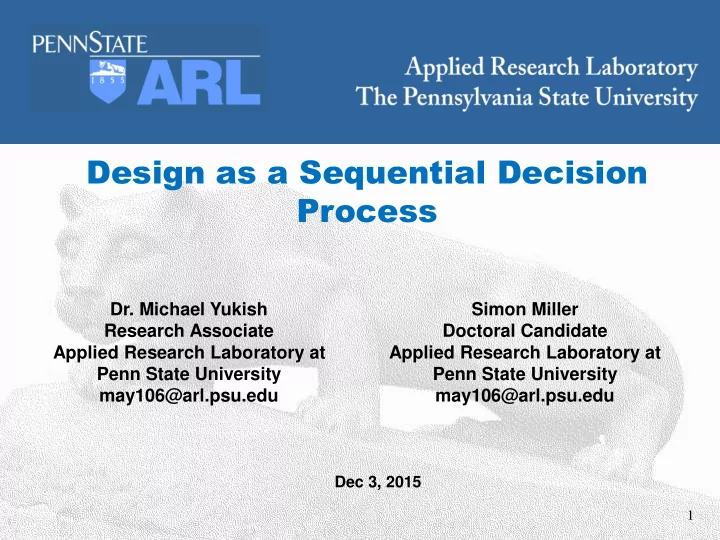

ARL Design as a Sequential Decision Process Dr. Michael Yukish Simon Miller Research Associate Doctoral Candidate Applied Research Laboratory at Applied Research Laboratory at Penn State University Penn State University may106@arl.psu.edu may106@arl.psu.edu Dec 3, 2015 1
Summary ARL • PSU has developed and evolved a preliminary Sequential Decision Framework for Model-Based Design that provides two key contributions: • A framework for linking models into a chain of increasing detail • An approach for determining an optimal sequential model chain • Approach is being brought to bear on a number of problems/projects • UAV design • Rotorcraft NextGenDesign tool development • Army investment portfolio management • NSF Resilient Buildings Project • For each, similar steps… • Identifying the trade space • Identifying the models used in the design process, with a focus on evolving levels detail • Looking to build initial test case model chains to support a design process • Use the problem to drive extensions to the framework • Understanding how the framework changes modeling 2
Design as a sequential decision process ARL Problem Framing Universal Set • Preferences are constructed during the process – Different strategies used at different times – Noncompensatory versus compensatory TSE i with Model i • Payne et al, (Psychology) • Balling (Design engineering) • Consideration Choice is a sequential process of reducing the Set i size of sets and increasing detail Revisit a Previous Model and Trade Space – Universal, consideration(s) and choice sets – Shocker (Marketing) TSE i+1 develop • Conceptual design is a Sequential Decision models Process modify model, input – bounds, analyses, etc. Customer and provider both gain knowledge throughout the process generate data – Defer commitment to best use knowledge – Explicitly acknowledge it visualize data • Singer, Doerry (Set- based Design…Naval Arch) • Frye (Pugh Controlled explore sensitivities, eliminate Convergence…Engineering Design) sets, explore limits, highlight • ARL/Penn State preferences, etc. • How decision posed significantly affects choice – Prospect theory, framing effects • Kahneman, Tversky Consideration Set i+1
Many potential paths through the design/modeling process ARL • Lots of models to potentially use • Low fidelity employed initially, help focus effort – models provide rapid feedback at reduced cost • As a design progresses, the model fidelity increases – More accuracy – asymptotically approaches reality – Cost increases superlinearly – Higher fidelity = more inputs and outputs and more variable interactions • Space to be considered decreases in breadth • Questions – how should models link together? – What is the “best” modeling path? 4
Formal Model of Connection ARL • Assume a detailed and a conceptual model – Detailed (high fidelity): v=g d (x,y) – Conceptual (low fidelity): v=g c (x) • Goal is to – Find x* and y* that minimize v – Use the cheaper concept model to cull the space first • Define g c to return bounds on detailed model 5
An example problem: cantilevered beam ARL • 1D FEA of a Cantilevered Beam with Tip Loading – Inputs: root and tip radii of the conical beam – Outputs: mass, tip displacement • Formulation: – Single Objective: min X (0.2 mass + 0.8 δ tip ) – Multi-Objective: min X (mass, δ tip ) • Model Fidelity = #finite elements 6
Optimal Modeling Policies ARL • Discriminatory power approaches the analytic result asymptotically • SO yields 1 solution • MO yields 327 alternatives • MO Formulation: P 500 ={6,49,188,500} • SO Formulation: P 500 ={2,4,13,33,62,500} • 4-fold reduction in cost – 100-fold reduction in cost 7
General Observations ARL • Sequential model – Neatly aligns with set-based design – Decision-makers already implicitly make these decisions – Attempting to place formalism on the process • Concept-Detailed Modeling Connection – Key piece to the sequential model process – Building good bounding models requires understanding of the physics of the problem – The value function plays a core role • Must trace bounds to values • Multiple objectives greatly reduces discriminatory power of models • Broadly Applicable, e.g. – Equations that can be discretized – Cost modeling strategies – Rapid heuristics solvers to NP-hard problems – Time step simulations 8
Recommend
More recommend